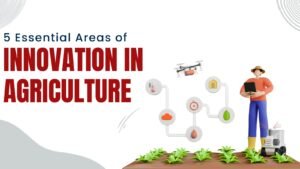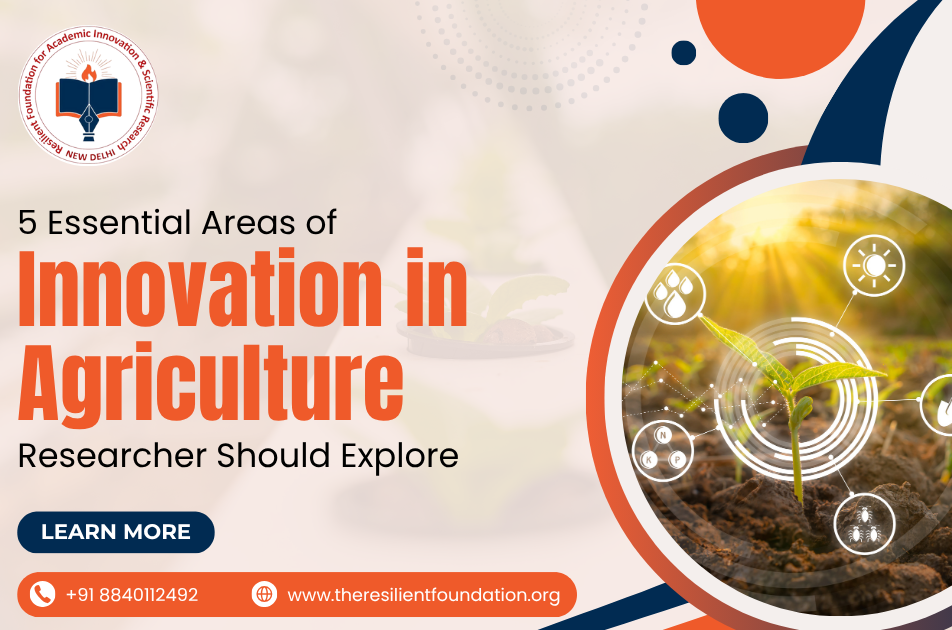Farming is not just about growing food anymore. Now, farmers face numerous significant challenges, including climate change, limited water resources, and an increasing population to feed. As a result, they require more effective methods for growing food. This is why innovation in agriculture is very important today.
New ideas and tools help farmers work smarter. At Resilient Foundation, we want to help people learn these new methods. We do this through our online workshops and training programs, which are made for students, farmers, and researchers who want to learn and grow.
5 Essential Areas of Innovation in Agriculture

There are five main areas where innovation in agriculture is making a big difference. These areas help farmers solve real problems. They help grow more food, protect nature, and save time and money. Each of these areas also gives new ideas for research and development. If you are a researcher or student, you should explore these areas.
Digital Agriculture and Data Analytics
Today, farmers can use machines and apps to make better decisions. They don’t need to guess anymore. They use data to know what their land needs.
Top 3 Benefits of Digital Agriculture:
- Smarter Crop Planning: Farmers use sensors and drones to check the soil and crops. If the soil is dry or low in nutrients, they get alerts. So, they only give water and fertilizers where needed. This saves time and money.
- Precision Farming: GPS machines help plant seeds in straight lines and apply fertilizers only in the right places. Because of that, farmers use fewer chemicals, and crops grow better.
- Real-Time Monitoring: With data tools, farmers can check their farms daily. They get early warnings about bad weather or pests. So, they can fix problems before it’s too late.
We explain these tools in our training programs, and many agricultural research projects also use them.
Biotechnology and Genetic Engineering
Sometimes crops cannot grow well because of pests or bad weather. But innovation in agriculture with biotechnology gives us better crops that can fight these problems.
Top 3 Benefits of Biotechnology in Agriculture:
- Disease Resistance: Scientists change the genes of plants so they can fight pests and diseases by themselves. So, farmers don’t need to use many harmful sprays.
- Higher Yield: With better genes, crops can grow more food from the same land. This is helpful because the world needs more food.
- Better Nutrition: Crops can be made to have more vitamins and minerals. So, people who eat them get healthier.
These topics are taught in our online workshops, and they are a big part of agricultural research today.
Climate Adaptation Technologies
The weather is not the same anymore. Sometimes it rains too much or too little. Innovation in agriculture helps farmers deal with these changes.
Top 3 Benefits of Climate-Smart Technologies:
- Drought-Tolerant Seeds: These seeds grow even when there is very little water. So, farmers can still grow crops during dry seasons.
- Smart Greenhouses: These are special houses that keep the plants safe. They control heat, water, and air. So, even in bad weather, crops can grow well.
- Climate Forecast Tools: These tools tell farmers about future weather. If a storm or flood is coming, they can plan better and save their crops.
Water Management Innovations
Water is very important in farming, but clean water is becoming less available. So, we must use it very carefully.
Top 3 Benefits of Water-Saving Solutions:
- Drip Irrigation: This system gives water directly to the roots of the plant. It does not waste water. So, farmers save water, and the plants grow well.
- Soil Moisture Sensors: These sensors tell farmers when the soil is dry. So, they only water when needed. This saves a lot of water.
- Water Recycling: Treated water is cleaned and reused for farming. This helps protect natural water sources.
We teach all of these methods in our training programs, and they are good for sustainable agriculture.
Agroforestry and Ecosystem Integration
Nature has many helpful things, like trees, insects, and animals. If we use them well, we can grow better crops. Innovation in agriculture also includes working with nature.
Top 3 Benefits of Agroforestry:
- Better Soil Health: Trees help keep the soil safe and full of nutrients. Their leaves fall and make the soil better. So, the land stays strong.
- Extra Income for Farmers: Trees grow fruits, nuts, or wood. Farmers can sell these and earn more money along with their crops.
- More Biodiversity: When farms have trees, they attract birds, bees, and good insects. These help the crops and protect the land.
These natural methods are promoted in our research and development work. We also teach them in our online workshops.
Conclusion
At Resilient Foundation, we believe learning is the key to change. These five areas of innovation in agriculture are helping farmers solve real problems and grow better food. But people need to learn how to use them. That is why we offer helpful online workshops and practical training programs to teach students, researchers, and farmers. We explain everything in simple language and give real-life examples that are easy to understand.
If you are interested in agricultural research or want to work in sustainable agriculture, now is the best time to begin.

